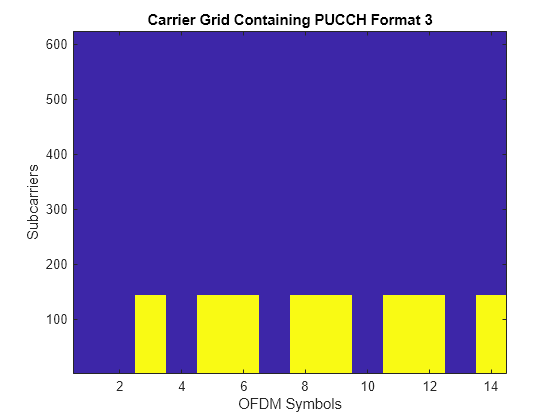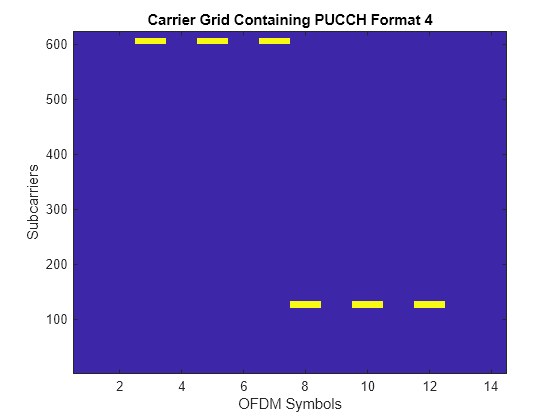nrPUCCHIndices
Syntax
Description
[
generates ind,info] = nrPUCCHIndices(carrier,pucch)ind, which contains 1-based physical uplink control channel
(PUCCH) resource element (RE) indices, as defined in TS 38.211 Section 6.3.2 [1] for all PUCCH formats.
carrier specifies the carrier configuration.
pucch specifies the PUCCH configuration. The function also generates
info, which contains information about the bit capacity and symbol
capacity of the uplink control information (UCI) on the PUCCH.
Examples
Create a default carrier configuration object. This object corresponds to a 10 MHz carrier with 15 kHz subcarrier spacing.
carrier = nrCarrierConfig;
Create a default PUCCH format 0 configuration object.
pucch0 = nrPUCCH0Config;
Specify the size of the bandwidth part (BWP) as 35 and the starting PRB index of the BWP relative to CRB 0 as 12. Specify the first symbol index in the PUCCH transmission slot as 3 and the number of allocated PUCCH symbols as 2. Set the PRB allocated for the PUCCH to 20, enable intraslot frequency hopping, and set the starting PRB index of the second hop to 10.
pucch0.NSizeBWP = 35;
pucch0.NStartBWP = 12;
pucch0.SymbolAllocation = [3 2];
pucch0.PRBSet = 20;
pucch0.FrequencyHopping = 'intraSlot';
pucch0.SecondHopStartPRB = 10;Generate PUCCH format 0 RE indices, setting the index orientation with respect to the carrier grid.
[ind,info] = nrPUCCHIndices(carrier,pucch0,'IndexOrientation','carrier')
ind = 24×1 uint32 column vector
2257
2258
2259
2260
2261
2262
2263
2264
2265
2266
2267
2268
2761
2762
2763
⋮
info = struct with fields:
G: 24
Gd: 24
NREPerPRB: 24
DMRSSymbolSet: [1×0 double]
PRBSet: 20
Plot the generated REs for PUCCH format 0 in the carrier resource grid.
resGrid = nrResourceGrid(carrier); resGrid(ind) = 1; imagesc(resGrid) axis xy xlabel('OFDM Symbols') ylabel('Subcarriers') title('Carrier Grid Containing PUCCH Format 0')

Create a default carrier configuration object.
carrier = nrCarrierConfig;
Specify a 60 kHz carrier with extended cyclic prefix. Set the number of RBs in the carrier resource grid to 55 and the slot number to 12.
carrier.SubcarrierSpacing = 60;
carrier.CyclicPrefix = 'extended';
carrier.NSizeGrid = 55;
carrier.NSlot = 12;Create a default PUCCH format 1 configuration object.
pucch1 = nrPUCCH1Config;
Specify the first symbol index in the PUCCH transmission slot as 3 and the number of allocated PUCCH symbols as 8. Enable intraslot frequency hopping and set the starting PRB index of the second hop to 35.
pucch1.NSizeBWP = []; % Set NSizeBWP equal to the NSizeGrid property of carrier pucch1.NStartBWP = []; % Set NStartBWP equal to the NStartGrid property of carrier pucch1.SymbolAllocation = [3 8]; pucch1.FrequencyHopping = 'intraSlot'; pucch1.SecondHopStartPRB = 35;
Generate PUCCH format 1 RE indices.
[ind,info] = nrPUCCHIndices(carrier,pucch1)
ind = 48×1 uint32 column vector
2641
2642
2643
2644
2645
2646
2647
2648
2649
2650
2651
2652
3961
3962
3963
⋮
info = struct with fields:
G: 48
Gd: 48
NREPerPRB: 48
DMRSSymbolSet: [3 5 7 9]
PRBSet: 0
Plot the generated REs for PUCCH format 1 in the carrier resource grid.
resGrid = nrResourceGrid(carrier); resGrid(ind) = 1; imagesc(resGrid) axis xy xlabel('OFDM Symbols') ylabel('Subcarriers') title('Carrier Grid Containing PUCCH Format 1')

Create a default carrier configuration object.
carrier = nrCarrierConfig;
Specify the number of RBs in the carrier resource grid as 24, the start of the carrier resource grid relative to CRB 0 as 20, and the slot number as 43.
carrier.NSizeGrid = 24; carrier.NStartGrid = 20; carrier.NSlot = 43;
Create a default PUCCH format 2 configuration object.
pucch2 = nrPUCCH2Config;
Specify the first symbol index in the PUCCH transmission slot as 5 and the number of allocated PUCCH symbols as 2. Set the PRBs allocated for the PUCCH to range from 0 to 15 and enable intraslot frequency hopping. Set the starting PRB index of the second hop to 7.
pucch2.SymbolAllocation = [5 2];
pucch2.PRBSet = 0:15;
pucch2.FrequencyHopping = 'intraSlot';
pucch2.SecondHopStartPRB = 7;Generate PUCCH format 2 RE indices.
[ind,info] = nrPUCCHIndices(carrier,pucch2)
ind = 256×1 uint32 column vector
1441
1443
1444
1446
1447
1449
1450
1452
1453
1455
1456
1458
1459
1461
1462
⋮
info = struct with fields:
G: 512
Gd: 256
NREPerPRB: 16
DMRSSymbolSet: [5 6]
PRBSet: [0 1 2 3 4 5 6 7 8 9 10 11 12 13 14 15]
Plot the generated REs for PUCCH format 2 in the carrier resource grid.
resGrid = nrResourceGrid(carrier); resGrid(ind) = 1; imagesc(resGrid) axis xy xlabel('OFDM Symbols') ylabel('Subcarriers') title('Carrier Grid Containing PUCCH Format 2')

Create a default carrier configuration object.
carrier = nrCarrierConfig;
Create a default PUCCH format 3 configuration object.
pucch3 = nrPUCCH3Config;
Specify the PRB allocation of the PUCCH to range from 0 to 11. Set the first symbol index in the PUCCH transmission slot to 2 and the number of allocated PUCCH symbols to 12. Enable the additional DM-RS configuration flag.
pucch3.NSizeBWP = []; pucch3.NStartBWP = []; pucch3.PRBSet = 0:11; pucch3.SymbolAllocation = [2 12]; pucch3.AdditionalDMRS = 1;
Generate PUCCH format 3 RE indices, setting the index orientation with respect to the carrier grid.
[ind,info] = nrPUCCHIndices(carrier,pucch3,'IndexOrientation','carrier')
ind = 1152×1 uint32 column vector
1249
1250
1251
1252
1253
1254
1255
1256
1257
1258
1259
1260
1261
1262
1263
⋮
info = struct with fields:
G: 2304
Gd: 1152
NREPerPRB: 96
DMRSSymbolSet: [3 6 9 12]
PRBSet: [0 1 2 3 4 5 6 7 8 9 10 11]
Plot the generated REs for PUCCH format 3 in the carrier resource grid.
resGrid = nrResourceGrid(carrier); resGrid(ind) = 1; imagesc(resGrid) axis xy xlabel('OFDM Symbols') ylabel('Subcarriers') title('Carrier Grid Containing PUCCH Format 3')

Create a default carrier configuration object.
carrier = nrCarrierConfig;
Create a default PUCCH format 4 configuration object.
pucch4 = nrPUCCH4Config;
Specify the modulation scheme as pi/2-BPSK and the allocated PRB for the PUCCH as 50. Set the first symbol index in the PUCCH transmission slot to 2 and the number of allocated PUCCH symbols to 10. Enable intraslot frequency hopping and the additional DM-RS configuration flag. Set the starting PRB index of the second hop to 10.
pucch4.Modulation = 'pi/2-BPSK'; pucch4.PRBSet = 50; pucch4.SymbolAllocation = [2 10]; pucch4.FrequencyHopping = 'intraSlot'; pucch4.SecondHopStartPRB = 10; pucch4.AdditionalDMRS = 1;
Generate the PUCCH format 4 RE indices.
[ind,info] = nrPUCCHIndices(carrier,pucch4)
ind = 72×1 uint32 column vector
1849
1850
1851
1852
1853
1854
1855
1856
1857
1858
1859
1860
3097
3098
3099
⋮
info = struct with fields:
G: 36
Gd: 36
NREPerPRB: 72
DMRSSymbolSet: [3 5 8 10]
PRBSet: 50
Plot the generated REs for PUCCH format 4 in the carrier resource grid.
resGrid = nrResourceGrid(carrier); resGrid(ind) = 1; imagesc(resGrid) axis xy xlabel('OFDM Symbols') ylabel('Subcarriers') title('Carrier Grid Containing PUCCH Format 4')

Input Arguments
Carrier configuration parameters for a specific OFDM numerology, specified as an
nrCarrierConfig
object. This function only uses these nrCarrierConfig object properties.
PUCCH configuration parameters, specified as one of these options.
For format 0, specify an
nrPUCCH0Configobject. The function uses only these object properties.For format 1, specify an
nrPUCCH1Configobject. The function uses only these object properties.For format 2, specify an
nrPUCCH2Configobject. The function uses only these object properties.For format 3, specify an
nrPUCCH3Configobject. The function uses only these object properties.For format 4, specify an
nrPUCCH4Configobject. The function uses only these object properties.
For PUCCH formats 0 to 3 and operation with
shared spectrum channel access for frequency range 1 (FR1), set the corresponding
Interlacing property to true, and use the
RBSetIndex and InterlaceIndex object
properties to specify the allocated frequency resources. In addition, for PUCCH formats
2 and 3, you can use the SpreadingFactor and
OCCI properties to specify single-interlace
configurations. (since R2023b)
Name-Value Arguments
Specify optional pairs of arguments as
Name1=Value1,...,NameN=ValueN, where Name is
the argument name and Value is the corresponding value.
Name-value arguments must appear after other arguments, but the order of the
pairs does not matter.
Before R2021a, use commas to separate each name and value, and enclose
Name in quotes.
Example: 'IndexStyle','subscript' specifies the RE indexing form of
the output.
RE indexing form, specified as one of these values:
'index'— The indices are in linear index form.'subscript'— The indices are in [subcarrier, symbol, antenna] subscript row form.
Data Types: char | string
RE indexing base, specified as one of these values:
'1based'— The index counting starts from 1.'0based'— The index counting starts from 0.
Data Types: char | string
RE indexing orientation, specified as one of these values:
'carrier'— Indices are referenced with respect to the carrier grid.'bwp'— Indices are referenced with respect to the BWP.
Data Types: char | string
Output Arguments
PUCCH RE indices, returned as one of these values:
Column vector — The function returns this type of value when you set the
IndexStylename-value argument to'index'.M-by-3 matrix — The function returns this type of value when you set the
IndexStylename-value argument to'subscript'. The matrix rows correspond to the [subcarrier, symbol, antenna] subscripts based on the number of subcarriers, OFDM symbols, and number of antennas, respectively.
Depending on the value of IndexBase, the function returns
either 1-based or 0-based indices. Depending on the value of
IndexOrientation, the function returns either carrier-oriented
indices or BWP-oriented indices.
Data Types: uint32
PUCCH resource information, returned as a structure containing these fields. The
output data type of each field is double.
| Field | Description |
|---|---|
G | Bit capacity of the PUCCH, returned as a value that is equal to the length of the UCI encoded codeword for formats 2, 3, and 4. |
Gd | Symbol capacity of the PUCCH |
NREPerPRB | Number of REs per PRB allocated to the PUCCH (including the spreading factor) |
DMRSSymbolSet | Set of 0-based OFDM symbol locations in a slot containing the demodulation reference signal (DM-RS) |
| PRBs allocated for PUCCH within the BWP |
References
[1] 3GPP TS 38.211. “NR; Physical channels and modulation.” 3rd Generation Partnership Project; Technical Specification Group Radio Access Network.
Extended Capabilities
C/C++ Code Generation
Generate C and C++ code using MATLAB® Coder™.
Version History
Introduced in R2021aUse the IntraCellGuardBands object property of the carrier input
to specify intracell guard bands.
For PUCCH formats 0 to 3, use the Interlacing,
RBSetIndex, and InterlaceIndex object properties
of the
pucch
input argument to configure interlaced PUCCH transmissions. In addition, for PUCCH formats 2
and 3, you can use the SpreadingFactor and OCCI
properties with single-interlace configurations.
Theinfo output argument also returns the PRBs allocated for PUCCH
within the BWP.
For C/C++ code generation, the limitation to specify name-value arguments as compile-time constants has been removed.
See Also
Functions
Objects
MATLAB Command
You clicked a link that corresponds to this MATLAB command:
Run the command by entering it in the MATLAB Command Window. Web browsers do not support MATLAB commands.
Select a Web Site
Choose a web site to get translated content where available and see local events and offers. Based on your location, we recommend that you select: .
You can also select a web site from the following list
How to Get Best Site Performance
Select the China site (in Chinese or English) for best site performance. Other MathWorks country sites are not optimized for visits from your location.
Americas
- América Latina (Español)
- Canada (English)
- United States (English)
Europe
- Belgium (English)
- Denmark (English)
- Deutschland (Deutsch)
- España (Español)
- Finland (English)
- France (Français)
- Ireland (English)
- Italia (Italiano)
- Luxembourg (English)
- Netherlands (English)
- Norway (English)
- Österreich (Deutsch)
- Portugal (English)
- Sweden (English)
- Switzerland
- United Kingdom (English)